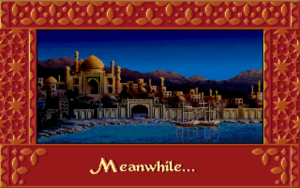 It’s been a while since your game’s scheming villain has actually shown up. There’s a good reason for that–you know the player will try to kill her as soon as she appears, and there’s only so many times you can place her beyond a uncrossable chasm or behind a force field. But you still want to remind the player she exists and show her behind-the-scenes plotting.
It’s been a while since your game’s scheming villain has actually shown up. There’s a good reason for that–you know the player will try to kill her as soon as she appears, and there’s only so many times you can place her beyond a uncrossable chasm or behind a force field. But you still want to remind the player she exists and show her behind-the-scenes plotting.
Or maybe your game adaptation of the Odyssey needs some Penelope scenes to reinforce that, yes–Penelope is pretty awesome and worth fighting monsters and gods to return to. You want to show how she’s handling her own troubles back home to inspire the player.
Or maybe you want to show Sidekick Guy getting murdered back at the base while the player is out on a mission. Or maybe you want to show the Great Dragon slowly awakening beneath the earth. Or maybe…
…well, you get the point. You want to switch away from the player’s point of view and use a cutscene to provide information or atmosphere you couldn’t otherwise get across. In a film, you wouldn’t think twice about it.
Here’s my advice: Think twice. That’s not to say you shouldn’t switch viewpoints for a cutscene in a video game. The advantages are obvious (and pretty much the same as they are in traditional, non-interactive media–thus, not worth discussing in great detail here) but there’s a lot to consider before you jump in. Continue reading
